
100W 6P45S mono block tube amplifier
Mads Barnkob, Sun Dec 01 2013, 02:23PMThe idea to build these amplifiers came with purchasing a set of old studio monitors, the legendary JBL 4333. These 75 Watt speakers with 15″ bass drivers needed a amplifier that could deliver some more punch than my 20 Watt EL34 amplifier.
Huben Panev here from 4hv helped me source twenty 6P45S beam power tetrodes, tv sweep tubes, the equivalent of PL519. The original plan was really to build a VTTC with 20 tubes in parallel, but balancing issues with 20 tubes with very different characteristics due to being used was a major setback for that project.
A big thanks to Steve Conner for helping me sort out various mistakes, improvements and fault finding :)
The complete article with all pictures, information etc:

DONE:
Prototype microcontroller software
Prototype enclosure
Prototype amplifier circuit
Prototype power supply
Start up and test with tone generator
Measurements with oscilloscope
Music test
Final enclosure
Final amplifier PCB
Final power supply PCB
TODO
Measurement and shutdown hardware
Measurement and shutdown software
I based the design on a rebuild of a old Easteuropean amplifier, the APX-100, Claus Byrith EL34 and a amplifier called KT88 Beastie from user Kruesti on diyaudio.com using long tailed pair for balancing the pre amplifier and phase splitter stages.
It it possible for the 6P45S to deliver approximately 120 Watt and will also have their bias adjusted for around 100 Watt, but will never be driven harder than the 50 Watt output transformers can handle.
I plan to build in a AVR microcontroller for showing voltages and currents on a LCD, making output stage adjustments/balancing easier and emergency shutdown to protect speakers automatic.
Monostage schematic
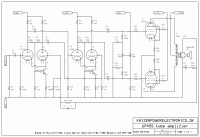
Power supply schematic (OBSOLETE, look for most recent version in latest posts, these schematics are kept as they were valid for the prototype)
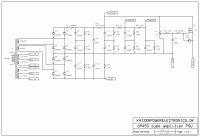
The prototype is built from scrap materials and BirdNestTechnology 2.0
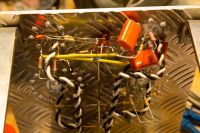
Choosing the values for power supply resistors

The prototype finally working.
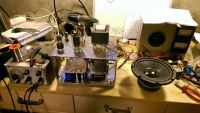
Re: 100W 6P45S mono block tube amplifier
Shrad, Sun Dec 01 2013, 08:31PM
yay, I just have four of them in a box somewhere... I just have to dig for them now! thanks for this contributions!
Shrad, Sun Dec 01 2013, 08:31PM
yay, I just have four of them in a box somewhere... I just have to dig for them now! thanks for this contributions!
Re: 100W 6P45S mono block tube amplifier
Mads Barnkob, Wed Dec 18 2013, 09:29PM
Edit: OBSOLETE SCHEMATICS, look further in the thread for latest schematics.
Updated schematics with corrections and especially PSU have had a lot of changes.


Mads Barnkob, Wed Dec 18 2013, 09:29PM
Edit: OBSOLETE SCHEMATICS, look further in the thread for latest schematics.
Updated schematics with corrections and especially PSU have had a lot of changes.


Re: 100W 6P45S mono block tube amplifier
Shrad, Thu Dec 19 2013, 08:51AM
I'm really amazed at the 100W rating you mention... I always thought a pair would deliver something like 20W at its maximum, as a tube can deliver 35W max rating as in the datasheet of the PL509
I should really dig for my tubes and start my own amp... something for the holidays ^^
Shrad, Thu Dec 19 2013, 08:51AM
I'm really amazed at the 100W rating you mention... I always thought a pair would deliver something like 20W at its maximum, as a tube can deliver 35W max rating as in the datasheet of the PL509
I should really dig for my tubes and start my own amp... something for the holidays ^^
Re: 100W 6P45S mono block tube amplifier
Mads Barnkob, Fri Dec 20 2013, 08:40PM
Here are the wave forms from yesterdays testing.
From wave of lowest amplitude to largest it is 23V(73VA), 26V(92VA), 28V(107VA) and 30V(123VA). I used a dummy load of 7,3 Ohm.
These numbers are of course the peak voltage across the resistive load, so the power output at 123VA with a guessed efficiency of 0,85 would be 74 Watt RMS.
The HF response is not quite as good as expected and I will do some more tests with different NFB circuit values to see if I can lessen the amount of rounding on the rising edge.

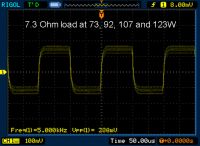

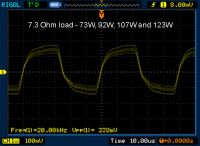
Mads Barnkob, Fri Dec 20 2013, 08:40PM
Here are the wave forms from yesterdays testing.
From wave of lowest amplitude to largest it is 23V(73VA), 26V(92VA), 28V(107VA) and 30V(123VA). I used a dummy load of 7,3 Ohm.
These numbers are of course the peak voltage across the resistive load, so the power output at 123VA with a guessed efficiency of 0,85 would be 74 Watt RMS.
The HF response is not quite as good as expected and I will do some more tests with different NFB circuit values to see if I can lessen the amount of rounding on the rising edge.




Re: 100W 6P45S mono block tube amplifier
Sigurthr, Fri Dec 20 2013, 10:21PM
Before you rework the NFB you may want to do the music test. This is an audio amp after all, the HF components in a 20kHz square wave should be above human hearing. If there isn't truly significant dampening of a 24kHz sine then I'd call it good. Just my two pence.
Sigurthr, Fri Dec 20 2013, 10:21PM
Before you rework the NFB you may want to do the music test. This is an audio amp after all, the HF components in a 20kHz square wave should be above human hearing. If there isn't truly significant dampening of a 24kHz sine then I'd call it good. Just my two pence.
Re: 100W 6P45S mono block tube amplifier
Mads Barnkob, Sat Dec 21 2013, 10:03AM
You are right, I talked with Steve Conner about this last night and looking at the wave forms there was only a drop from 28,4 Volt at 1kHz to 27,2 Volt at 20kHz, so it is only -0.375dB.
Today I will do some tests on -3dB of clipping power and find the -3dB lower and upper frequency. Then I will decide weather to experiment further with NFB values.
Edit:
I tested the above with my 7R3 resistive dummy load and a 8R speaker. It seems there i absolutely no reason to change anything on the amplifier. The square wave tests showed some rounding that should be expected on 10kHz as the transformer can not pass the 100kHz harmonics. The sine wave tests shows great linear band width.
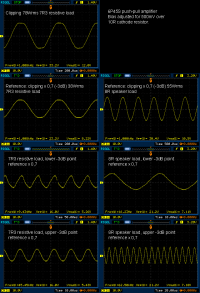
Mads Barnkob, Sat Dec 21 2013, 10:03AM
Sigurthr wrote ...
Before you rework the NFB you may want to do the music test. This is an audio amp after all, the HF components in a 20kHz square wave should be above human hearing. If there isn't truly significant dampening of a 24kHz sine then I'd call it good. Just my two pence.
Before you rework the NFB you may want to do the music test. This is an audio amp after all, the HF components in a 20kHz square wave should be above human hearing. If there isn't truly significant dampening of a 24kHz sine then I'd call it good. Just my two pence.
You are right, I talked with Steve Conner about this last night and looking at the wave forms there was only a drop from 28,4 Volt at 1kHz to 27,2 Volt at 20kHz, so it is only -0.375dB.
Today I will do some tests on -3dB of clipping power and find the -3dB lower and upper frequency. Then I will decide weather to experiment further with NFB values.
Edit:
I tested the above with my 7R3 resistive dummy load and a 8R speaker. It seems there i absolutely no reason to change anything on the amplifier. The square wave tests showed some rounding that should be expected on 10kHz as the transformer can not pass the 100kHz harmonics. The sine wave tests shows great linear band width.

Re: 100W 6P45S mono block tube amplifier
Shrad, Sat Dec 21 2013, 07:23PM
definitely a winner amp, for a simplicity and price point of view, and the fact I have everything in my bins ^^
after chritsmas I'll have gathered a big copper plate for making a chassis out of copper and nice wood :)
Shrad, Sat Dec 21 2013, 07:23PM
definitely a winner amp, for a simplicity and price point of view, and the fact I have everything in my bins ^^
after chritsmas I'll have gathered a big copper plate for making a chassis out of copper and nice wood :)
Re: 100W 6P45S mono block tube amplifier
Sigurthr, Sat Dec 21 2013, 10:09PM
It really is a beautiful piece of work. I'm just glad I was able to help :) .
Sigurthr, Sat Dec 21 2013, 10:09PM
It really is a beautiful piece of work. I'm just glad I was able to help :) .
Re: 100W 6P45S mono block tube amplifier
Mads Barnkob, Sat Jan 04 2014, 07:12PM
Second performance measurements after NFB capacitor is changed from 1nF (41kHz cutoff) to 0.47nF(87kHz cutoff), the bandwidth of the amplifier was increased and clipping occurs at higher power than earlier measurements.
The prototype is now considered done as it has proved itself capable of outputting 210 Watt peak before clipping. At 100 Watt peak it have its -3dB points at 11 Hz and 72 kHz.
I forgot to set the V/div correct, so all voltages should be multiplied by 100 or just read them with one decimal like 39.2mV is 39.2V
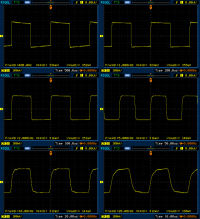
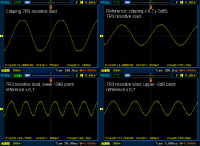
Mads Barnkob, Sat Jan 04 2014, 07:12PM
Second performance measurements after NFB capacitor is changed from 1nF (41kHz cutoff) to 0.47nF(87kHz cutoff), the bandwidth of the amplifier was increased and clipping occurs at higher power than earlier measurements.
The prototype is now considered done as it has proved itself capable of outputting 210 Watt peak before clipping. At 100 Watt peak it have its -3dB points at 11 Hz and 72 kHz.
I forgot to set the V/div correct, so all voltages should be multiplied by 100 or just read them with one decimal like 39.2mV is 39.2V


Re: 100W 6P45S mono block tube amplifier
Mads Barnkob, Thu Jun 11 2015, 10:39AM
23rd June 2014
I made new printed circuit boards, both for the power supply and amplifier. There was some changes to the power supply from the prototype. I added 150V stabiliser tubes for the 300V supply and the screen supply is also on the board.
Everything is installed in a enclosure from the Italian company HIFI2000.

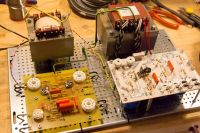
25th November 2014
The first power up and test with signal generator as the amplifier is installed in its enclosure. There is some problems with hum that will have to be investigated.
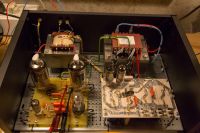
Signal generator test:
Mads Barnkob, Thu Jun 11 2015, 10:39AM
23rd June 2014
I made new printed circuit boards, both for the power supply and amplifier. There was some changes to the power supply from the prototype. I added 150V stabiliser tubes for the 300V supply and the screen supply is also on the board.
Everything is installed in a enclosure from the Italian company HIFI2000.


25th November 2014
The first power up and test with signal generator as the amplifier is installed in its enclosure. There is some problems with hum that will have to be investigated.

Signal generator test:
Re: 100W 6P45S mono block tube amplifier
Mads Barnkob, Mon Jun 15 2015, 01:29PM
8th June 2015
Further investigation of hum issues was conducted by waving a isolated 1000VDC rated screw driver around in proximity of different components while watching the secondary side of the output transformer on my oscilloscope.
I identified two vulnerable places where a great deal of noise could be induced through capacitive coupling and there is also sensitive to noise through induction from magnetic fields.
The first issue was a small part of the signal line in coaxial cable that was not shielded. Explanations are written on each screenshot from the oscilloscope. The first pictures show the output without any interference with the circuit. The second shows the effect of touching the isolation on the part of the signal line in cable that was not shielded.
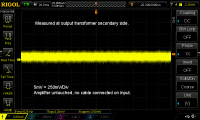
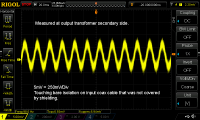
The second issue was the coupling capacitor in the input circuit before the pre-amplifier. The yellow wave form with the highest amplitude show the induced noise by touching it as it was installed.
The two blue wave form screenshots show the test to locate the pin connected to the outer foil layer in the capacitor, the capacitor is simply connected to the signal and ground of the oscilloscope probe and squeezed around with your fingers. Switch the connections around to perform it at reverse polarity.
The wave form with the lowest amplitude tells us that the pin currently connected to the ground clip is the pin connected internally to the outer foil layer in the capacitor. This outer layer will also function as a shield in high impedance circuits and that pin should be connected to ground or the path with lowest impedance towards ground.
Now the question is, did it help? Measurable yes, on any audible hum performance heard with a human ear... not really :)
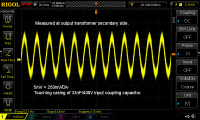
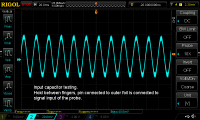
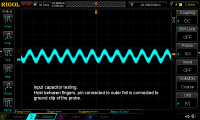

Update #2
All wave forms are from the secondary side of the output transformer.
The first oscilloscope screenshot shows a Fast Fourier Transform (FFT) analysis of the noise generated by the normal diodes for the 340VAC high voltage supply 1N5408 and 40VAC bias supply 1N4007.
The second oscilloscope screenshot shows the difference between normal diodes like 1N5408/1N4007 that have reverse recovery times around 2uS and fast diodes like MUR480/MUR420 that have reverse recovery times around 50nS is shown in the oscilloscope screenshot with yellow and green wave forms. The spike amplitude is around 15% less but the overall 50Hz hum at the positive half cycle is a little more prominent. Changing the diodes gave a difference in the sound from the switching spikes.
The third oscilloscope screenshot shows the much reduced noise levels after a ground loop formed from star ground point to signal input plug was removed and along with the much shorter switching spikes from the new fast diodes.
Audible it appeared like 90% of the hum disappeared. The greatest performance gain was however from removing a ground loop, the faster diodes did not have such a dramatic effect, it was hear able, but not on the magnitude of removing the ground loop.

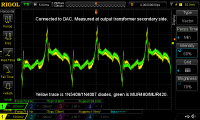

Also a music test :)
Mads Barnkob, Mon Jun 15 2015, 01:29PM
8th June 2015
Further investigation of hum issues was conducted by waving a isolated 1000VDC rated screw driver around in proximity of different components while watching the secondary side of the output transformer on my oscilloscope.
I identified two vulnerable places where a great deal of noise could be induced through capacitive coupling and there is also sensitive to noise through induction from magnetic fields.
The first issue was a small part of the signal line in coaxial cable that was not shielded. Explanations are written on each screenshot from the oscilloscope. The first pictures show the output without any interference with the circuit. The second shows the effect of touching the isolation on the part of the signal line in cable that was not shielded.


The second issue was the coupling capacitor in the input circuit before the pre-amplifier. The yellow wave form with the highest amplitude show the induced noise by touching it as it was installed.
The two blue wave form screenshots show the test to locate the pin connected to the outer foil layer in the capacitor, the capacitor is simply connected to the signal and ground of the oscilloscope probe and squeezed around with your fingers. Switch the connections around to perform it at reverse polarity.
The wave form with the lowest amplitude tells us that the pin currently connected to the ground clip is the pin connected internally to the outer foil layer in the capacitor. This outer layer will also function as a shield in high impedance circuits and that pin should be connected to ground or the path with lowest impedance towards ground.
Now the question is, did it help? Measurable yes, on any audible hum performance heard with a human ear... not really :)




Update #2
All wave forms are from the secondary side of the output transformer.
The first oscilloscope screenshot shows a Fast Fourier Transform (FFT) analysis of the noise generated by the normal diodes for the 340VAC high voltage supply 1N5408 and 40VAC bias supply 1N4007.
The second oscilloscope screenshot shows the difference between normal diodes like 1N5408/1N4007 that have reverse recovery times around 2uS and fast diodes like MUR480/MUR420 that have reverse recovery times around 50nS is shown in the oscilloscope screenshot with yellow and green wave forms. The spike amplitude is around 15% less but the overall 50Hz hum at the positive half cycle is a little more prominent. Changing the diodes gave a difference in the sound from the switching spikes.
The third oscilloscope screenshot shows the much reduced noise levels after a ground loop formed from star ground point to signal input plug was removed and along with the much shorter switching spikes from the new fast diodes.
Audible it appeared like 90% of the hum disappeared. The greatest performance gain was however from removing a ground loop, the faster diodes did not have such a dramatic effect, it was hear able, but not on the magnitude of removing the ground loop.



Also a music test :)
Re: 100W 6P45S mono block tube amplifier
Mads Barnkob, Mon Sept 28 2015, 07:11AM
The manual MOSFET linear regulation part of the power supply for the screens have also been scrapped and replaced by a resistor. It was stable and fine at operation, but every now and then it would short circuit on power up of the amplifier.
After playing around with the audio analyzer looped back to itself, I forgot I had it set for 6V output and hooked the amplifier up for a FR test. This resulted in OPT arcing over and I had to take it apart, no visible damages, but secondary side measures only half the DC resistance as the OPT I have for the other mono block, I will have to hi-pot test it to see if its really dead or can be saved with a little jiggling and varnish.
-----------
New measurements with a fresh OPT installed, the one that arced gives some spurious 0.5 to 1 Ohm DC resistance on the secondary side, it does not look like its good for anything but brief weighting.
Dummy load was a 8.6 Ohm 200 Watt resistor and thus the output power from the output level test gives some 70 Watt out at 0.5 V in. The other tests are done at 0.5 V input too.
I had the amplifier hooked up to my JBL 4333s for the first time and it is now obvious that there is a reason for the high thd+n measurements, there is a great deal of noise, still not sure which kind, but sounds like white and harmonic.
It plays pretty well, not too sure about bass yet, seems to vary a lot by the music, Metallica still has evil deep punch, whereas some other artists are flattened a bit.
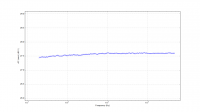

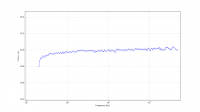
Mads Barnkob, Mon Sept 28 2015, 07:11AM
The manual MOSFET linear regulation part of the power supply for the screens have also been scrapped and replaced by a resistor. It was stable and fine at operation, but every now and then it would short circuit on power up of the amplifier.
After playing around with the audio analyzer looped back to itself, I forgot I had it set for 6V output and hooked the amplifier up for a FR test. This resulted in OPT arcing over and I had to take it apart, no visible damages, but secondary side measures only half the DC resistance as the OPT I have for the other mono block, I will have to hi-pot test it to see if its really dead or can be saved with a little jiggling and varnish.
-----------
New measurements with a fresh OPT installed, the one that arced gives some spurious 0.5 to 1 Ohm DC resistance on the secondary side, it does not look like its good for anything but brief weighting.
Dummy load was a 8.6 Ohm 200 Watt resistor and thus the output power from the output level test gives some 70 Watt out at 0.5 V in. The other tests are done at 0.5 V input too.
I had the amplifier hooked up to my JBL 4333s for the first time and it is now obvious that there is a reason for the high thd+n measurements, there is a great deal of noise, still not sure which kind, but sounds like white and harmonic.
It plays pretty well, not too sure about bass yet, seems to vary a lot by the music, Metallica still has evil deep punch, whereas some other artists are flattened a bit.



Re: 100W 6P45S mono block tube amplifier
Mads Barnkob, Sun Nov 15 2015, 03:48PM
A sad side note to the testing described above is that I had the audio analyzer looped to itself for testing and output voltage was set to the maximum 5V. I forgot about this setting and hooked the amplifier up to the audio analyzer and just as test began there was sparks flying from the output transformer and some smoke. The output transformer is damaged from internal arcing and I will have to buy a new one.
I changed the output transformer with the one I had for the 2nd amplifier. The output transformer was also shifted 90 degrees on two axis's in order to cancel any possible magnetic coupling to the power transformer. It did however not show any difference in measurements on the audio analyzer.
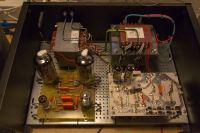
Mads Barnkob, Sun Nov 15 2015, 03:48PM
A sad side note to the testing described above is that I had the audio analyzer looped to itself for testing and output voltage was set to the maximum 5V. I forgot about this setting and hooked the amplifier up to the audio analyzer and just as test began there was sparks flying from the output transformer and some smoke. The output transformer is damaged from internal arcing and I will have to buy a new one.
I changed the output transformer with the one I had for the 2nd amplifier. The output transformer was also shifted 90 degrees on two axis's in order to cancel any possible magnetic coupling to the power transformer. It did however not show any difference in measurements on the audio analyzer.

Re: 100W 6P45S mono block tube amplifier
Ash Small, Mon Nov 16 2015, 02:08PM
I'm still learning the basics of this stuff, just about ready to put my power supply together, and due to pick up some parafeed chokes and a big OT this week, but is it worth adding some DC blocking capacitors to the OT? This would also limit saturation, if this is an issue. Otherwise, I'd try a larger OT. Also, how well is the output impedance matched to the speaker impedance?
Ash Small, Mon Nov 16 2015, 02:08PM
I'm still learning the basics of this stuff, just about ready to put my power supply together, and due to pick up some parafeed chokes and a big OT this week, but is it worth adding some DC blocking capacitors to the OT? This would also limit saturation, if this is an issue. Otherwise, I'd try a larger OT. Also, how well is the output impedance matched to the speaker impedance?
Re: 100W 6P45S mono block tube amplifier
Hazmatt_(The Underdog), Tue Nov 17 2015, 04:23AM
Ash, you don't use DC blocking caps on the OT. The center tap feeds DC current to the plate of the tubes through the winding, a blocking cap between the plate lead and the transformer lead would "shut off" the tube.
Also the output is totally isolated from the primary, so there is no reason to have any DC blocking in the output portion of the circuit. If you wanted a Zobel network, that is a different story.
OPT's match fairly well because you are changing an impedance based on the turns ratio, which can be controlled quite well. the last transformer I measured with a HP vector impedance meter was right on, and this was a cheapo $25 5W OPT.
Hazmatt_(The Underdog), Tue Nov 17 2015, 04:23AM
Ash, you don't use DC blocking caps on the OT. The center tap feeds DC current to the plate of the tubes through the winding, a blocking cap between the plate lead and the transformer lead would "shut off" the tube.
Also the output is totally isolated from the primary, so there is no reason to have any DC blocking in the output portion of the circuit. If you wanted a Zobel network, that is a different story.
OPT's match fairly well because you are changing an impedance based on the turns ratio, which can be controlled quite well. the last transformer I measured with a HP vector impedance meter was right on, and this was a cheapo $25 5W OPT.
Re: 100W 6P45S mono block tube amplifier
Ash Small, Tue Nov 17 2015, 04:51AM
Maybe a DC blocking cap was the wrong term to use. Maybe you are correct, I'm not that familiar with push-pull output valves, but surely all transformers work on AC?
I was just thinking you could limit saturation using capacitors, maybe it's not possible.
I do know a common mistake people make is not using a large enough output transformer, and then wondering why it doesn't sound as expected.
Also, matching the impedance of the output valves to the impedance of the speaker(s) isn't always as straightforward as it might first appear, from the research I've done.
I think I'll stick with single ended with parafeed for now
Ash Small, Tue Nov 17 2015, 04:51AM
Hazmatt_(The Underdog) wrote ...
Ash, you don't use DC blocking caps on the OT. The center tap feeds DC current to the plate of the tubes through the winding, a blocking cap between the plate lead and the transformer lead would "shut off" the tube.
Also the output is totally isolated from the primary, so there is no reason to have any DC blocking in the output portion of the circuit. If you wanted a Zobel network, that is a different story.
OPT's match fairly well because you are changing an impedance based on the turns ratio, which can be controlled quite well. the last transformer I measured with a HP vector impedance meter was right on, and this was a cheapo $25 5W OPT.
Ash, you don't use DC blocking caps on the OT. The center tap feeds DC current to the plate of the tubes through the winding, a blocking cap between the plate lead and the transformer lead would "shut off" the tube.
Also the output is totally isolated from the primary, so there is no reason to have any DC blocking in the output portion of the circuit. If you wanted a Zobel network, that is a different story.
OPT's match fairly well because you are changing an impedance based on the turns ratio, which can be controlled quite well. the last transformer I measured with a HP vector impedance meter was right on, and this was a cheapo $25 5W OPT.
Maybe a DC blocking cap was the wrong term to use. Maybe you are correct, I'm not that familiar with push-pull output valves, but surely all transformers work on AC?
I was just thinking you could limit saturation using capacitors, maybe it's not possible.
I do know a common mistake people make is not using a large enough output transformer, and then wondering why it doesn't sound as expected.
Also, matching the impedance of the output valves to the impedance of the speaker(s) isn't always as straightforward as it might first appear, from the research I've done.
I think I'll stick with single ended with parafeed for now

Re: 100W 6P45S mono block tube amplifier
TwirlyWhirly555, Tue Nov 17 2015, 06:39AM
Nice project ,
I do need to try and make a PP vlave amp oneday , I've only made single ended ones that never made it to a proper case apart from one for a hybrid cassette amp
TwirlyWhirly555, Tue Nov 17 2015, 06:39AM
Nice project ,
I do need to try and make a PP vlave amp oneday , I've only made single ended ones that never made it to a proper case apart from one for a hybrid cassette amp
Re: 100W 6P45S mono block tube amplifier
Mads Barnkob, Tue Nov 17 2015, 09:36AM
I made no further considerations about what type of speakers I have connected. 8 Ohm tapped output transformer is all I need and then find a output transformer with a primary impedance that matches the load impedance chosen for the output tubes.
Thank you and just throw yourself into it, start out with a small EL84 pp amp, there are some good designs outthere and some well proven ones like:
My next tube amplifiers are going to be a couple of single end 250TH amplifiers, never tried a SE yet :) I might aswell design it and order the transformers needed now that I have to get new OPT for this 6P45S amplifier.
Mads Barnkob, Tue Nov 17 2015, 09:36AM
Ash Small wrote ...
Also, matching the impedance of the output valves to the impedance of the speaker(s) isn't always as straightforward as it might first appear, from the research I've done.
I think I'll stick with single ended with parafeed for now
Also, matching the impedance of the output valves to the impedance of the speaker(s) isn't always as straightforward as it might first appear, from the research I've done.
I think I'll stick with single ended with parafeed for now

I made no further considerations about what type of speakers I have connected. 8 Ohm tapped output transformer is all I need and then find a output transformer with a primary impedance that matches the load impedance chosen for the output tubes.
TwirlyWhirly555 wrote ...
Nice project ,
I do need to try and make a PP vlave amp oneday , I've only made single ended ones that never made it to a proper case apart from one for a hybrid cassette amp
Nice project ,
I do need to try and make a PP vlave amp oneday , I've only made single ended ones that never made it to a proper case apart from one for a hybrid cassette amp
Thank you and just throw yourself into it, start out with a small EL84 pp amp, there are some good designs outthere and some well proven ones like:

My next tube amplifiers are going to be a couple of single end 250TH amplifiers, never tried a SE yet :) I might aswell design it and order the transformers needed now that I have to get new OPT for this 6P45S amplifier.
Re: 100W 6P45S mono block tube amplifier
Ash Small, Tue Nov 17 2015, 03:46PM
Mads, if you do end up with two OT's, the easy way to see if one is large enough is to series two, and see if it sounds any better.
The one you have looks to be a reasonable size, though. Just an easy way of checking.
Ash Small, Tue Nov 17 2015, 03:46PM
Mads, if you do end up with two OT's, the easy way to see if one is large enough is to series two, and see if it sounds any better.
The one you have looks to be a reasonable size, though. Just an easy way of checking.
Re: 100W 6P45S mono block tube amplifier
TwirlyWhirly555, Tue Nov 17 2015, 04:42PM
No problem , I love seeing valve based amps , especially building them threads .
Thanks for the Link I will look into that :D
My amps are only small things based on the ECC82 triode / 50EH5 pentode , gives about 2W out SE but I used it in combination with a cassette head preamp IC . I do like SE for in many cases you can get a fairly decent amp with just 3 tubes and not to many components and then go further if you wanted to
I did make a KT88 SE amp but never finished it . I am planning on making a 1W SE amp using the subminature pentode and dual triode tubes you can get ,should turn out better than my first valve amp >
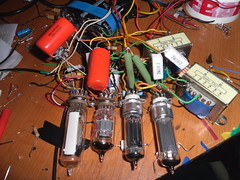 SAM_0962 by TwirlyWhirly555, on Flickr
SAM_0962 by TwirlyWhirly555, on Flickr
It did work thankfully though :P
TwirlyWhirly555, Tue Nov 17 2015, 04:42PM
Mads Barnkob wrote ...
Thank you and just throw yourself into it, start out with a small EL84 pp amp, there are some good designs outthere and some well proven ones like:
My next tube amplifiers are going to be a couple of single end 250TH amplifiers, never tried a SE yet :) I might aswell design it and order the transformers needed now that I have to get new OPT for this 6P45S amplifier.
TwirlyWhirly555 wrote ...
Nice project ,
I do need to try and make a PP vlave amp oneday , I've only made single ended ones that never made it to a proper case apart from one for a hybrid cassette amp
Nice project ,
I do need to try and make a PP vlave amp oneday , I've only made single ended ones that never made it to a proper case apart from one for a hybrid cassette amp
Thank you and just throw yourself into it, start out with a small EL84 pp amp, there are some good designs outthere and some well proven ones like:

My next tube amplifiers are going to be a couple of single end 250TH amplifiers, never tried a SE yet :) I might aswell design it and order the transformers needed now that I have to get new OPT for this 6P45S amplifier.
No problem , I love seeing valve based amps , especially building them threads .
Thanks for the Link I will look into that :D
My amps are only small things based on the ECC82 triode / 50EH5 pentode , gives about 2W out SE but I used it in combination with a cassette head preamp IC . I do like SE for in many cases you can get a fairly decent amp with just 3 tubes and not to many components and then go further if you wanted to
I did make a KT88 SE amp but never finished it . I am planning on making a 1W SE amp using the subminature pentode and dual triode tubes you can get ,should turn out better than my first valve amp >
 SAM_0962 by TwirlyWhirly555, on Flickr
SAM_0962 by TwirlyWhirly555, on FlickrIt did work thankfully though :P
Print this page